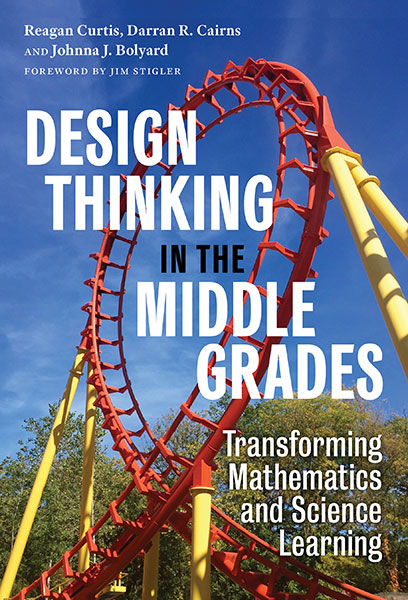Professors: Request an Exam Copy
Print copies available for US orders only. For orders outside the US, see our international distributors.
Reagan Curtis, Darran R. Cairns, Johnna J. Bolyard
Foreword by: James W. Stigler
Publication Date: March 24, 2023
Pages: 168

Too often, mathematics and science are taught in isolation from each other and from meaningful problems that matter to students. This book draws on the authors’ experiences with teacher colleagues, including time spent in their classrooms co-developing and refining lessons. The core of their approach is to encourage learners to pursue solutions to everyday challenges through design-based learning cycles. Students use mathematical modeling to describe or summarize a phenomenon, predict which potential solutions may be successful, and/or to test actual performance against predictions. The authors emphasize connecting grade-appropriate science and math content standards and integrating literacy with evidence-based argument through design briefs and presentations. Teachers will learn how to support productive struggle and structure group learning that promotes equity, while teaching in the classroom or virtually as needed.
The middle grades are a pivotal time to engage the next generation so that they are prepared to solve tomorrow's challenges. Classroom teachers, preservice educators, and faculty in teacher education programs can use Design Thinking in the Middle Grades as a foundational text for math, science, and integrated STEM teaching.
Reagan Curtis is a Chester E. and Helen B. Derrick Endowed Professor of educational psychology in the School of Education and founding director of the Program Evaluation and Research Center at West Virginia University. Darran R. Cairns is faculty in the School of Science and Engineering at the University of Missouri–Kansas City. Johnna J. Bolyard is an associate professor of mathematics education in the School of Education at West Virginia University.
“Students, in the end, not only learn the things they need to know based on current STEM content standards, but also walk away as practitioners of a disciplined approach to activating and using what they know to solve real problems in the world…I hope these ideas, and this approach, pick up steam here in the United States.”
—From the Foreword by James W. Stigler, Distinguished Professor of Psychology, UCLA
“Why limit students to learning about science and math when you could engage them in the authentic doing of science and math? The design-based learning model, which is expertly described and illustrated in this book, will help you do just that. If we want students to develop a passion for science and math, if we want them to solve the complex challenges facing our world, if we want them to be the innovators and creators, then we need to engage them in the type of authentic doing presented in this book. Read this book and meet the future of science and math education.”
—Kevin J. Pugh, professor, educational psychology, University of Northern Colorado
Contents
Foreword James W. Stigler xi
Acknowledgments xiii
Introduction 1
Part I: Understanding the Approach
1. Thinking Differently About Teaching and Learning 9
What It Looks Like in a Real Classroom 9
Why This Book? 12
2. Engineering Design, Mathematics, Science, and Literacy 17
A Visual Model of Our Approach 18
The Design Process: Dynamic, Iterative Waves of Divergent and Convergent Thinking 19
Integrating Mathematical Modeling, Scientific Challenges, and Literacy Practices 24
3. Affordances and Supports 29
Supporting Productive Struggle by Learners 30
Promoting Equity in the Classroom 32
Complex Instruction 33
Reflective Teaching Practice 36
Leveraging the Design Process for Reflective Teaching 38
4. Why Do We Think This Works? 41
Evidence-Based Teaching Practices 41
Evidence Base for Core Components of Our Approach 46
Evidence Base for Bringing It All Together 49
5. Personifying Best Practices 53
(Re)Designing Industrial Farming in Your State 53
Connecting Theory to Practice 55
Part II: Making It Real
6. Design and Mathematical Modeling—From Artifacts to Processes 63
Affordances for Systems-Level Learning Across the Artifact-to-Process Continuum 65
Returning to the Grocery Store 70
7. How Constraints and Criteria Affect Design and Mathematical Modeling 73
How Many Marbles Can You Fit in a Piece of Aluminum Foil Before It Sinks? 74
Keeping a Cold Drink Cold for Longer (Co-Constructing Constraints) 74
8. Scaffolding Student Learning in Design and Mathematical Modeling 79
Productive Struggle in Design-Based Learning 80
Scaffolding Productive Struggle 82
Strategically Using Formative Assessment Data 85
Giving Students Voice in Design Constraints, Criteria, and Methods of Assessment 87
9. Design and Mathematical Modeling Across Content Areas and Grade Levels 91
Gingerbread-House Lesson (6th-Grade Mathematics Class) 91
Predator/Prey Lesson (8th-Grade Science Class) 95
Skater-Ramp Lesson (7th-Grade Mathematics and Science Class) 98
Adapting Design-Based Learning Activities to Your Students 101
10. Design and Mathematical Modeling Across Instructional Modalities 105
Taking Design-Based Learning Online 106
Examples of Design-Based Learning at a Distance 108
Connecting Examples to Core Components, Affordances, and Supports 111
Part III: Making It Your Own
11. Linking an Integrative Series of Design and Mathematical Modeling Activities 115
Problem-Based, Design-Based, and Project-Based Integration 115
Energy and the Environment Thematic Unit 117
Pulling It All Together 122
12. Address Any Content Standard and ÒFixÓ Textbook Problems 123
Starting From Standards 123
Starting From Existing Activities or Problems 127
(Re)Designing Effective Teaching Practices 131
Conclusion: The Wicked Problem of Education for All 133
References 135
Index 143
About the Authors 147
Professors: Request an Exam Copy
Print copies available for US orders only. For orders outside the US, see our international distributors.